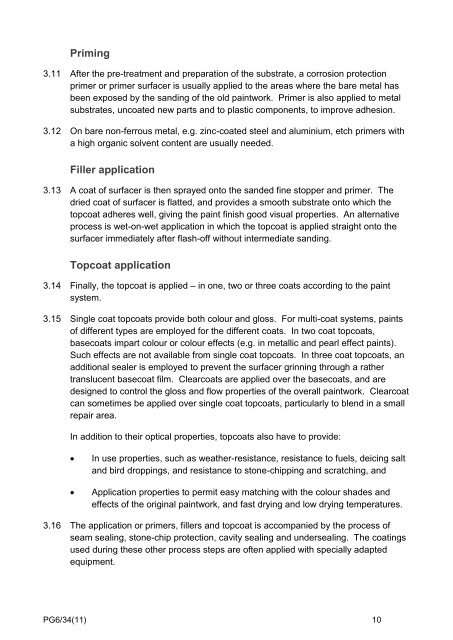Process Guidance Note 6/34(11) - Defra
Process Guidance Note 6/34(11) - Defra
Process Guidance Note 6/34(11) - Defra
Create successful ePaper yourself
Turn your PDF publications into a flip-book with our unique Google optimized e-Paper software.
Priming<br />
3.<strong>11</strong> After the pre-treatment and preparation of the substrate, a corrosion protection<br />
primer or primer surfacer is usually applied to the areas where the bare metal has<br />
been exposed by the sanding of the old paintwork. Primer is also applied to metal<br />
substrates, uncoated new parts and to plastic components, to improve adhesion.<br />
3.12 On bare non-ferrous metal, e.g. zinc-coated steel and aluminium, etch primers with<br />
a high organic solvent content are usually needed.<br />
Filler application<br />
3.13 A coat of surfacer is then sprayed onto the sanded fine stopper and primer. The<br />
dried coat of surfacer is flatted, and provides a smooth substrate onto which the<br />
topcoat adheres well, giving the paint finish good visual properties. An alternative<br />
process is wet-on-wet application in which the topcoat is applied straight onto the<br />
surfacer immediately after flash-off without intermediate sanding.<br />
Topcoat application<br />
3.14 Finally, the topcoat is applied – in one, two or three coats according to the paint<br />
system.<br />
3.15 Single coat topcoats provide both colour and gloss. For multi-coat systems, paints<br />
of different types are employed for the different coats. In two coat topcoats,<br />
basecoats impart colour or colour effects (e.g. in metallic and pearl effect paints).<br />
Such effects are not available from single coat topcoats. In three coat topcoats, an<br />
additional sealer is employed to prevent the surfacer grinning through a rather<br />
translucent basecoat film. Clearcoats are applied over the basecoats, and are<br />
designed to control the gloss and flow properties of the overall paintwork. Clearcoat<br />
can sometimes be applied over single coat topcoats, particularly to blend in a small<br />
repair area.<br />
In addition to their optical properties, topcoats also have to provide:<br />
<br />
<br />
In use properties, such as weather-resistance, resistance to fuels, deicing salt<br />
and bird droppings, and resistance to stone-chipping and scratching, and<br />
Application properties to permit easy matching with the colour shades and<br />
effects of the original paintwork, and fast drying and low drying temperatures.<br />
3.16 The application or primers, fillers and topcoat is accompanied by the process of<br />
seam sealing, stone-chip protection, cavity sealing and undersealing. The coatings<br />
used during these other process steps are often applied with specially adapted<br />
equipment.<br />
PG6/<strong>34</strong>(<strong>11</strong>) 10
















